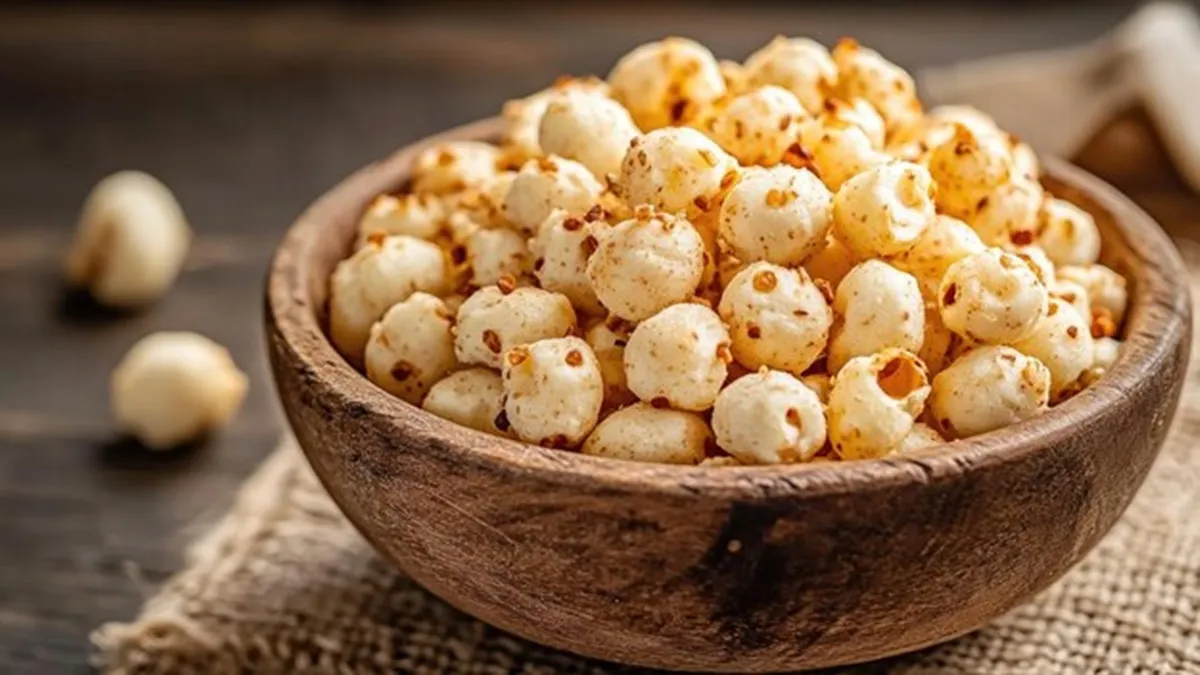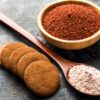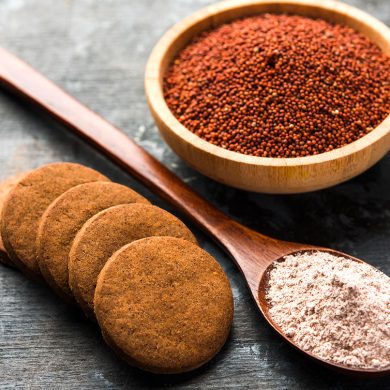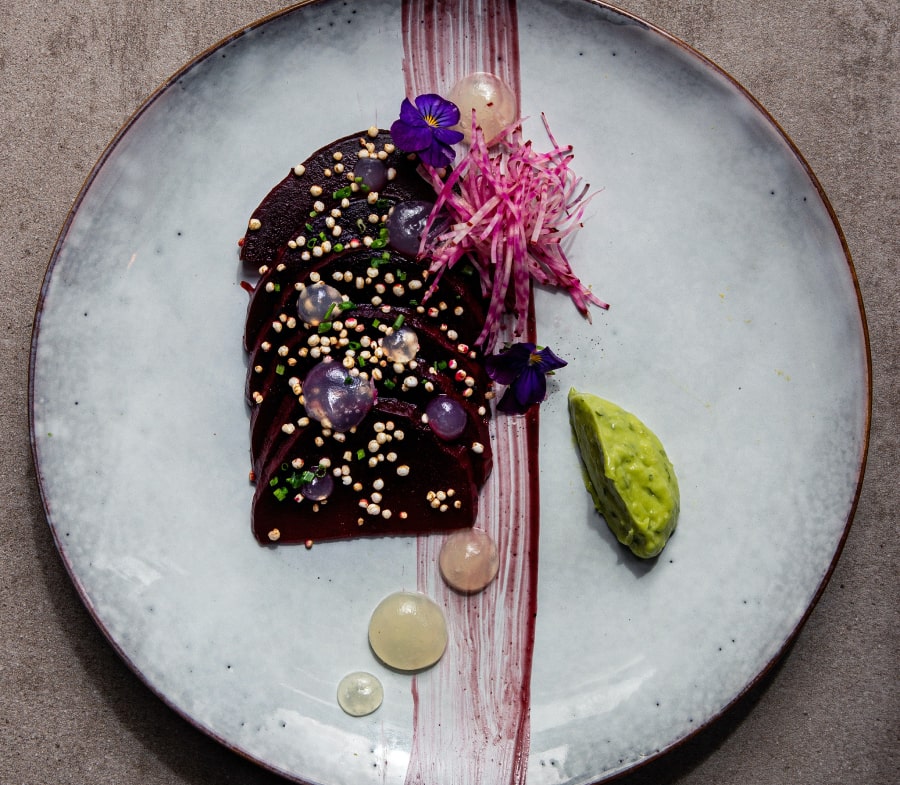Introduction
Yes, makhana is good for weight loss when consumed in the right portion and prepared healthily. It is a low-calorie, protein-rich, and fibre-packed snack that helps control hunger, supports digestion, and prevents overeating. If you want to dig deeper into how makhana works for weight management, its nutritional benefits, and the best ways to eat it, read further.
What is Makhana?
Makhana, also known as fox nuts or lotus seeds, is a superfood widely used in India. It is obtained from the seeds of the lotus flower and is consumed after roasting, which makes it crunchy and light.
For centuries, makhana has been part of Ayurveda and traditional diets, valued for its digestive, anti-ageing, and detoxifying properties. In modern times, it is gaining global attention as a healthy snack alternative to chips, fried foods, and processed munchies.
Nutritional Value of Makhana
Here is the approximate nutritional value of 100 grams of plain roasted makhana:
| Nutrient | Amount (per 100g) | Why It Matters for Weight Loss |
|---|---|---|
| Calories | 350–370 kcal | Lower than nuts and fried snacks |
| Protein | 9–10 g | Supports muscle repair, keeps you full |
| Carbohydrates | 65–67 g | Provides energy, slow-releasing |
| Fibre | 7–8 g | Aids digestion, controls hunger |
| Fat | 0.5–1 g | Very low compared to nuts |
| Calcium | 50–60 mg | Strengthens bones |
| Magnesium | 80–90 mg | Boosts metabolism |
| Potassium | 500–600 mg | Regulates blood pressure |
Key Insight: Compared to other snacks like chips or fried namkeens, makhana provides fewer calories, almost no unhealthy fats, and more protein and fibre, making it highly suitable for weight management.
How Makhana Helps in Weight Loss
Research shows that a high-protein and fibre-rich diet is effective for reducing calorie intake and improving satiety. Makhana supports weight loss in multiple ways:
Low in Calories & Fat
Makhana is naturally low in calories and almost fat-free, with around 350 calories per 100g compared to 500–600 in fried snacks. This makes it an excellent light snack option for weight watchers aiming to reduce overall calorie intake.
Protein Rich Snack
Protein in makhana helps release satiety hormones like peptide YY and GLP-1, which suppress hunger. Eating a protein-rich snack between meals reduces unnecessary cravings, making it easier to stick to a calorie-controlled weight loss plan.
Fibre Content
Rich in dietary fibre, makhana slows down digestion and keeps you fuller for longer. This prevents frequent snacking, controls appetite naturally, and supports digestive health, all of which are crucial for effective and sustainable weight management.
Low Glycaemic Index (GI)
Foods with a low GI, like makhana, release glucose slowly into the bloodstream, preventing sugar spikes and crashes. Research suggests low-GI diets aid weight management, improve insulin sensitivity, and reduce risks linked to diabetes and obesity.
Supports Metabolism
Makhana contains magnesium and potassium, two key minerals that regulate metabolism, energy balance, and fat utilisation. A healthy metabolism ensures calories are burned efficiently, supporting weight control and preventing the sluggishness often associated with calorie-restricted diets.
Best Ways to Eat Makhana for Weight Loss
Makhana can be included in your diet in several ways. The key is portion control and healthy preparation.
Roasted Makhana
Roast makhana in a dry pan without ghee or use minimal oil. Add light seasoning like rock salt, pepper, or turmeric. This preparation keeps calories low while enhancing flavour, making it a perfect guilt-free, crunchy snack for weight watchers.
Air-Fried Makhana
For a completely oil-free version, try air-frying makhana. It delivers the same crunch as roasted but with even fewer calories. Air-fried makhana is ideal for dieters looking for a light evening snack that doesn’t compromise on taste or health.
Masala Makhana
Lightly toss roasted makhana with mild spices such as cumin, curry leaves, or chilli powder. This adds flavour without excess fat. Masala makhana is a tasty, healthy replacement for fried namkeens and satisfies cravings while keeping your diet on track.
Portion Size
Moderation is essential for weight loss. Stick to 30–40 grams daily, which equals one to two cups of roasted makhana. This serving provides fibre and protein for satiety without excessive calories, preventing overeating while supporting steady fat reduction goals.
Best Time to Eat
The right timing enhances benefits. Makhana works best as a mid-morning snack, evening munch, or pre-workout fuel. It keeps energy levels stable, curbs hunger, and avoids high-calorie snacking, making it a strategic addition to a balanced weight-loss plan.
Tip from Nutritionists: Avoid sugar-coated, fried, or heavily processed makhana sold in markets. These versions add hidden calories, sugar, and fat that slow weight loss. Always choose plain roasted or air-fried makhana to maintain its nutritional value and achieve real results effectively.
Common Mistakes to Avoid
Many people assume that eating more makhana automatically leads to weight loss, but there are pitfalls:
- Eating makhana fried in ghee or oil.
- Consuming more than 70–80g daily (can add excess calories).
- Adding sugar, caramel, or heavy masalas.
- Relying only on makhana without balancing other nutrients.
Who Should Eat Makhana?
Makhana is suitable for almost everyone, but it is especially beneficial for:
Weight loss seekers
Makhana is an excellent snack for weight loss because it is low in calories yet rich in protein and fibre. It helps manage hunger, prevents overeating, and supports portion control, making it ideal for people on calorie-restricted diets.
Diabetics
For diabetics, makhana works well due to its low glycaemic index. It prevents sudden spikes in blood sugar while providing essential nutrients. Regular moderate intake supports glucose management and offers a healthy alternative to processed snacks or refined carbohydrate foods.
Fitness enthusiasts
Fitness enthusiasts benefit from makhana as it provides quick energy and plant-based protein. Eaten pre-workout, it fuels exercise without heaviness. Post-workout, it aids recovery and curbs hunger, offering a clean, nutrient-rich snack compared to commercial protein bars or fried foods.
Children and elderly
Makhana is soft, easily digestible, and nutrient-dense, making it perfect for children and elderly individuals. It provides calcium for bone strength, magnesium for metabolism, and antioxidants for immunity. Its light texture ensures comfort, even for those with sensitive digestion or dental issues.
Other Health Benefits Beyond Weight Loss
Weight loss is just one benefit. Makhana offers several additional health advantages:
- Heart Health: Low sodium and high potassium help regulate blood pressure.
- Diabetes Management: Low GI prevents sugar spikes.
- Bone Strength: Calcium and magnesium improve bone density.
- Anti-Ageing Properties: Antioxidants slow down cell damage.
- Kidney & Liver Function: Traditionally used for detoxification.
Is Makhana Better than Other Snacks?
Let’s compare:
Makhana vs Popcorn
Both are considered light snacks, but makhana provides more protein, fibre, and essential minerals compared to popcorn. While popcorn is lower in carbs, makhana offers better satiety and nutritional value, making it a smarter choice for weight management.
Makhana vs Chips
Chips are calorie-dense, fried in oil, and loaded with salt, often leading to weight gain and poor heart health. Makhana, on the other hand, is low in fat and calories, making it a significantly healthier replacement.
Makhana vs Nuts
Nuts are highly nutritious but also calorie-heavy, which can hinder weight loss if consumed in excess. Makhana delivers protein, fibre, and micronutrients with fewer calories, offering weight watchers a balanced and lighter alternative without compromising nutrition.
Verdict: Makhana is one of the best weight-loss snacks compared to most alternatives.
Recipes & Creative Ways to Add Makhana to Your Diet
Here are some simple ways to make your makhana intake more enjoyable:
- Basic Roasted Makhana: Dry roast and season with black pepper & rock salt.
- Spicy Masala Makhana: Toss roasted makhana with chilli, turmeric, and curry leaves.
- Herb Makhana: Add oregano, basil, and chilli flakes for an Italian twist.
- Makhana Smoothie Bowl: Blend makhana with fruits, yoghurt, and honey (for non-weight-loss diets).
- Makhana Chaat: Mix with cucumber, tomatoes, and mint chutney for a refreshing salad.
Conclusion
So, is makhana good for weight loss? Absolutely — provided it’s consumed in moderation and prepared healthily. Its low calories, high fibre, and protein content make it an ideal replacement for processed and fried snacks. For anyone aiming to lose weight or simply eat cleaner, makhana is a smart, sustainable choice.
FAQs
Q1. How much makhana can I eat daily for weight loss?
30–40g (1–2 cups roasted) is enough.
Q2. Can I eat makhana at night?
Yes, roasted makhana at night is safe and light on digestion.
Q3. Does makhana help reduce belly fat?
It helps in overall calorie reduction, which may reduce belly fat.
Q4. Is makhana good for diabetes patients?
Yes, due to its low GI, it helps control sugar spikes.
Q5. Can makhana cause weight gain?
Overeating or consuming fried/sugar-coated makhana can add calories and cause weight gain.










Add comment